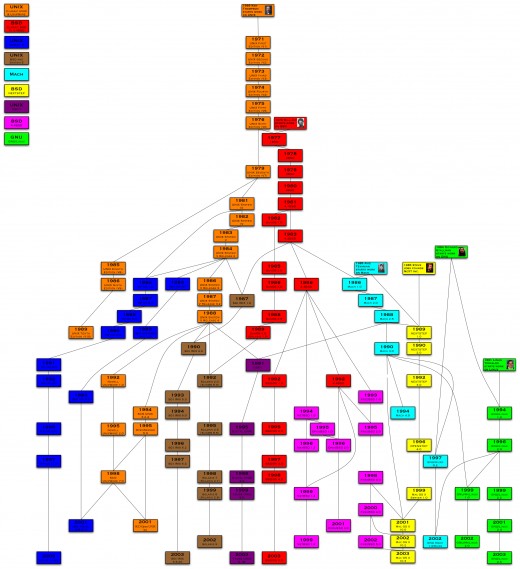UNIX FROM THE PAST
THE BEGINNING............
1969 The Beginning The history of UNIX starts back in 1969, when Ken Thompson, Dennis Ritchie and others started working on the "little-used PDP-7 in a corner" at Bell Labs and what was to become UNIX.
1971 First Edition It had a assembler for a PDP-11/20, file system, fork(), roff and ed. It was used for text processing of patent documents.
1973 Fourth Edition It was rewritten in C. This made it portable and changed the history of OS's.
1975 Sixth Edition UNIX leaves home. Also widely known as Version 6, this is the first to be widely available out side of Bell Labs. The first BSD version (1.x) was derived from V6.
1979 Seventh Edition It was a "improvement over all preceding and following Unices" [Bourne]. It had C, UUCP and the Bourne shell. It was ported to the VAX and the kernel was more than 40 Kilobytes (K).
1980 Xenix Microsoft introduces Xenix. 32V and 4BSD introduced.
1982 System III AT&T's UNIX System Group (USG) release System III, the first public release outside Bell Laboratories. SunOS 1.0 ships. HP-UX introduced. Ultrix-11 Introduced.
1983 System V Computer Research Group (CRG), UNIX System Group (USG) and a third group merge to become UNIX System Development Lab. AT&T announces UNIX System V, the first supported release. Installed base 45,000.
1984 4.2BSD University of California at Berkeley releases 4.2BSD, includes TCP/IP, new signals and much more. X/Open formed.
1984 SVR2 System V Release 2 introduced. At this time there are 100,000 UNIX installations around the world.
1986 4.3BSD 4.3BSD released, including internet name server. SVID introduced. NFS shipped. AIX announced. Installed base 250,000.
1987 SVR3 System V Release 3 including STREAMS, TLI, RFS. At this time there are 750,000 UNIX installations around the world. IRIX introduced.
1988 POSIX.1 published. Open Software Foundation (OSF) and UNIX International (UI) formed. Ultrix 4.2 ships.
1989 AT&T UNIX Software Operation formed in preparation for spinoff of USL. Motif 1.0 ships.
Save this image in your System for better view
Click thumbnail to view full-size
1990 XPG3 X/Open launches XPG3 Brand. OSF/1 debuts. Plan 9 from Bell Labs ships.
1991 UNIX System Laboratories (USL) becomes a company - majority-owned by AT&T. Linus Torvalds commences Linux development. Solaris 1.0 debuts.
1992 SVR4.2 USL releases UNIX System V Release 4.2 (Destiny). October - XPG4 Brand launched by X/Open. December 22nd Novell announces intent to acquire USL. Solaris 2.0 ships.
1993 4.4BSD 4.4BSD the final release from Berkeley. June 16 Novell acquires USL Late 1993 SVR4.2MP Novell transfers rights to the "UNIX" trademark and the Single UNIX Specification to X/Open. COSE initiative delivers "Spec 1170" to X/Open for fasttrack. In December Novell ships SVR4.2MP , the final USL OEM release of System V
1994 Single UNIX Specification BSD 4.4-Lite eliminated all code claimed to infringe on USL/Novell. As the new owner of the UNIX trademark, X/Open introduces the Single UNIX Specification (formerly Spec 1170), separating the UNIX trademark from any actual code stream.
1995 UNIX 95 X/Open introduces the UNIX 95 branding programme for implementations of the Single UNIX Specification. Novell sells UnixWare business line to SCO. Digital UNIX introduced. UnixWare 2.0 ships. OpenServer 5.0 debuts.
1996 The Open Group forms as a merger of OSF and X/Open.
1997 Single UNIX Specification, Version 2 The Open Group introduces Version 2 of the Single UNIX Specification, including support for realtime, threads and 64-bit and larger processors. The specification is made freely available on the web. IRIX 6.4, AIX 4.3 and HP-UX 11 ship.
1998 UNIX 98 The Open Group introduces the UNIX 98 family of brands, including Base, Workstation and Server. First UNIX 98 registered products shipped by Sun, IBM and NCR. The Open Source movement starts to take off with announcements from Netscape and IBM. UnixWare 7 and IRIX 6.5 ship.
1999 UNIX at 30 The UNIX system reaches its 30th anniversary. Linux 2.2 kernel released. The Open Group and the IEEE commence joint development of a revision to POSIX and the Single UNIX Specification. First LinuxWorld conferences. Dot com fever on the stock markets. Tru64 UNIX ships.
2001 Single UNIX Specification, Version 3 Version 3 of the Single UNIX Specification unites IEEE POSIX, The Open Group and the industry efforts. Linux 2.4 kernel released. IT stocks face a hard time at the markets. The value of procurements for the UNIX brand exceeds $25 billion. AIX 5L ships.
2003 ISO/IEC 9945:2003 The core volumes of Version 3 of the Single UNIX Specification are approved as an international standard. The "Westwood" test suite ship for the UNIX 03 brand. Solaris 9.0 E ships. Linux 2.6 kernel released.






